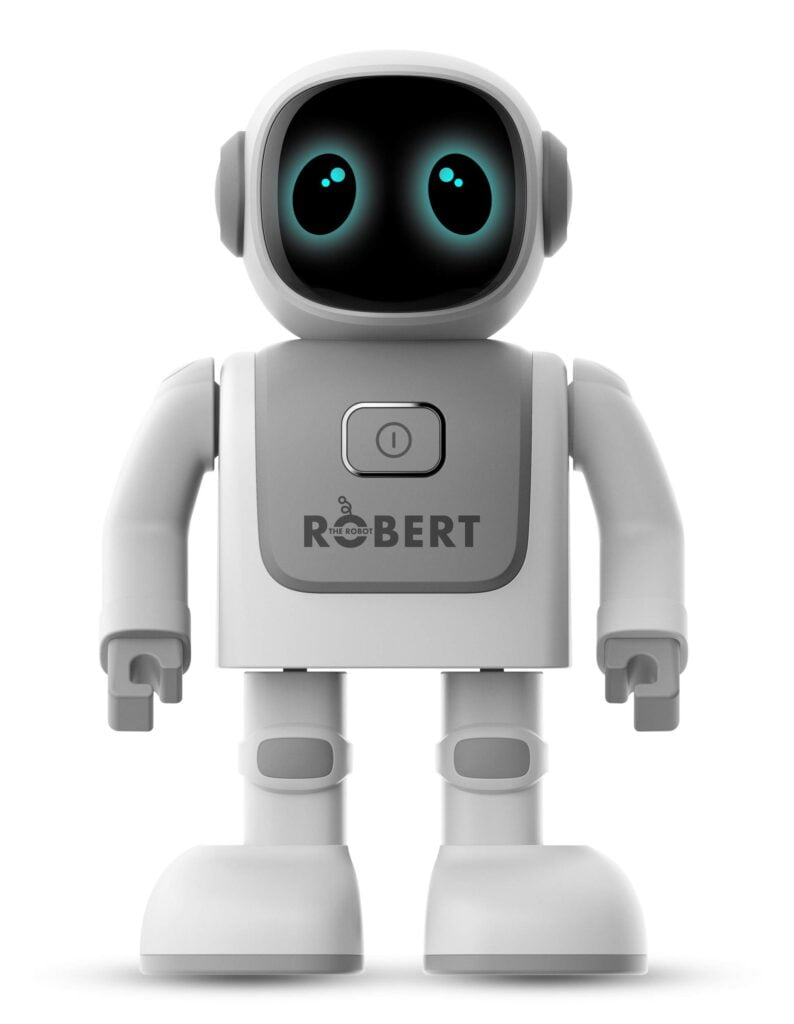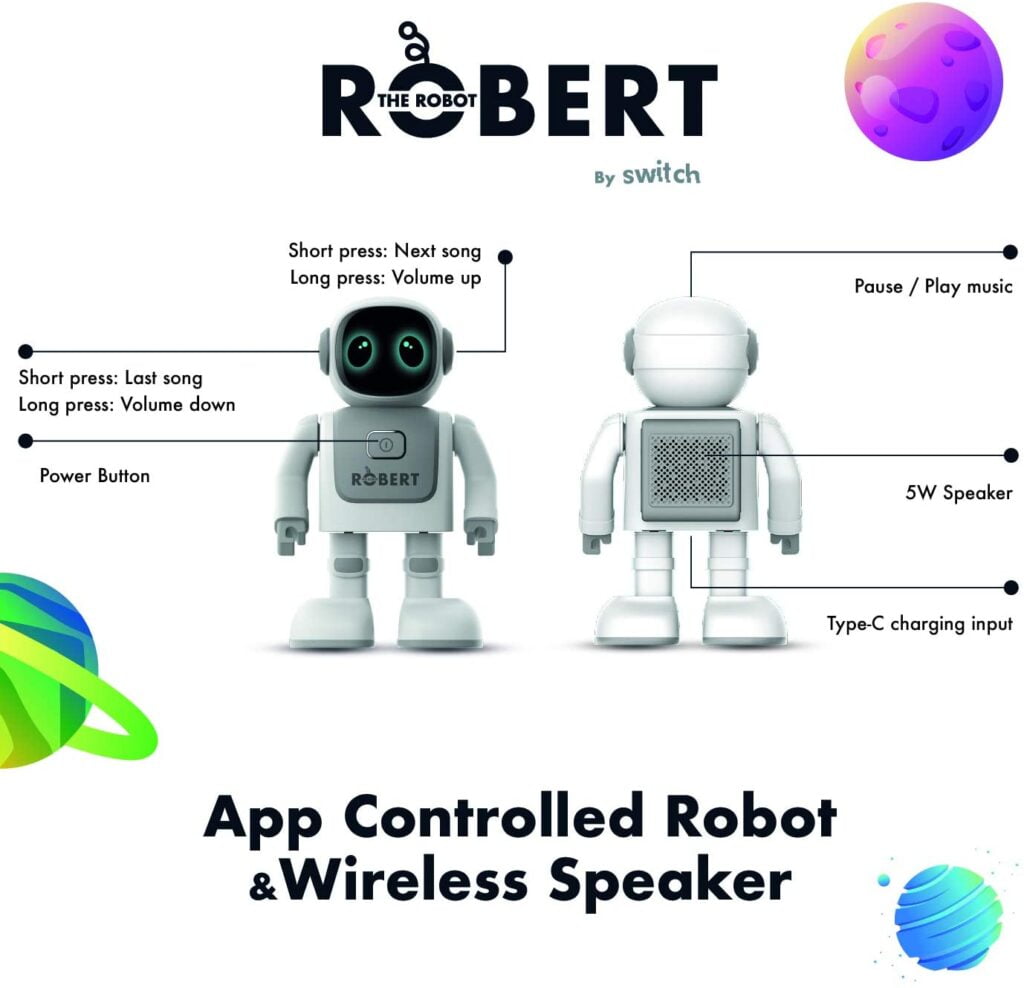Bluetooth-Speakers Hiper Robert have become obscene in recent years, offering customers a variety of features, looks, power, and more and more. But today we have a gadget in our editorial office, which, although it belongs to portable speakers, is at the same time an advanced toy. It is generally positioned as a “dancing programmable robot”, and children are seen as its main audience. However, as historical experience shows, there are many toys that were created as children’s toys, but became entertainment for adults. Hiper Robert is no exception. Moreover, with a price tag of more than 7 thousand rubles, it looks a little expensive for a child’s toy. However, its functionality is much wider than that of cheap models from Detsky Mir, which, in fact, can only play a given set of melodies, making monotonous movements. It is also interesting that the robot is made anthropomorphic, while most of these robotic speakers have wheels. In general, a curious device that can entertain a group of adults on New Year’s holidays, before becoming an inhabitant of the nursery. I will tell you about the pros and cons of choosing such a device.

Contents
Bluetooth-Speakers Hiper Robert Specifications
- Power : 5W
- Bluetooth : version 4.2
- Battery capacity : 1800mAh
- Working time : up to 240 minutes at ~ 70% volume
- Connectors : USB-C for charging, microSD slot (up to 128 GB)
- Dimensions : 178 x 112 x 84 mm
- Weight : 326 grams
- Features : App for iOS and Android, the ability to program a sequence of movements
Contents of delivery
• Radio-controlled robot HIPER “ROBERT” H-OT14
• Type-C cable for charging the battery
• Instruction
Bluetooth-Speakers Hiper Robert Appearance
As already mentioned, Hiper Robert depicts an anthropomorphic robot. It is a bit like the very first anthropomorphic robots from Japan, which they were very fond of dragging around 20 years ago at exhibitions, where they broadcast some advertising nonsense with a mechanical voice and waved their limbs. Only this robot is closer in size to a small Bluetooth speaker, that is, it will be possible to cover it with a man’s palm. The manufacturer indicates an increase of almost 18 cm. So the thing is compact and, according to women’s reviews, cute.



It also resembles an astronaut a little, apparently, the white-gray paintwork and the front panel, which looks like the visor of the helmet of a space suit, affect. This panel itself is black, glossy, with a single hole in the place where a person would have a mouth. In fact, it’s just a hole in the plastic, behind which there is nothing. But on the “visor” when turned on, the eyes light up. If desired, you can turn them off completely, then the “cosmonaut” will remain faceless, but you can choose one of seven color options (white, blue / turquoise, blue, green, yellow, red and purple).
This is not to say that the robot has many moving parts. The head is fixed motionless, the arms can only move up and down (the position bent at the elbows remains unchanged), he has no knees, his legs move at the point of attachment to the body, massive feet are deflected. At the same time, the robot manages to move really well and perform a specific dance.
Right in the middle of his chest, he has a button that is responsible, in general, for the same thing that Carlson’s button-down button was responsible for: turning on and starting movements. Below it is the Hiper logo.
On the back, in the form of a kind of knapsack, the musical apparatus itself is located, behind the grill of the round slots the speaker is hidden. There is a sticker with technical information on the bottom edge.
The soles of the feet are edged from softer plastic, plus they themselves are covered with some kind of soft and rough to the touch material, so there is no need to worry about the integrity of not only the laminate, but also no polishing.
All materials are quite durable and non-marking, the toy retains a completely presentable appearance even after repeated falls and not the most humane treatment. The only disadvantage is that when the movements are disabled, the movable joints are blocked – the child, with some effort, can break the robot. Plus, the manufacturer did not bother to make the screw connections hidden. They are not visible from the front, but the screws are clearly visible from the back and below. On the one hand, this is even not bad, since minor repairs may always be required and you will not need to think about how to disassemble this thing. On the other hand, the aesthetics have suffered somewhat. Whether it is important for an entertaining, not a fashion thing, everyone decides for himself.
Bluetooth-Speakers Hiper Robert Control
The moment we start talking about how to manage Hiper Robert, it reveals the reason why the brand is asking for quite a lot of money for a child’s toy. The robot can be used in two ways – completely autonomously and by connecting to a smartphone through a special application.
The first method assumes that you insert a memory card into which the music will be recorded. Of course, the player built into the speaker is quite simple and does not understand any uncompressed formats, which is quite logical, given that the gadget is by no means an audiophile. Cards are supported up to 128GB, which is pretty good. The only question is why it was necessary to close the memory card slot with a cap, which is fixed with a separate bolt. I suspect that these are some kind of restrictions related to obtaining a certificate for a child’s toy, but it looks strange and inconvenient.

In offline mode, you will not be able to select some of the robot’s settings (for example, the “eyes” will always turn on and light up in default color), but you can adjust the volume, switch songs and turn on / off dance mode. You will have to operate solely by pressing the buttons.
The button on the chest with a long press turns the robot on or off. Initially, it will turn on and track the music to perform movements to the beat, but if you briefly press the power button once, the “dance” will stop. The next short press will reactivate it. Double short press enables or disables playback, pausing it.
There are also buttons in the right and left “headphones” of the helmet / head. The left one is responsible for decreasing the volume and switching tracks in the opposite direction, the right one for increasing the volume and switching tracks forward in the list. To switch, you need a short press, and the volume is adjusted with long ones. And when I say long, it really means long presses. To switch from minimum to maximum volume level, you need to hold the button pressed for 15 seconds, no less. The speaker informs about reaching the maximum (or minimum) volume level with a loud beep.
When connected to a smartphone, Robert behaves like an ordinary Bluetooth speaker. True, as is typical for new and inexpensive speakers, it takes quite a long time to load. From the “off” position, it takes him almost half a minute to connect to a previously tied smartphone. Here it becomes more like the already mentioned old robots or the old Windows OS: first, you will hear the boot music, and the mechanisms will start to move. Then he will say “Hello, I am Robert” and wave his hands. Then it will freeze for a couple of moments, start moving again and repeat twice in different voices: “Oh, yeah! Oh, yeah! ” And only after that, after another second or two, the Bluetooth connection will be restored. And it doesn’t matter in which mode you turned off the column, the settings will be reset – the eyes will turn on the turquoise-blue color by default,
Playback controls remain the same. In fact, this is such an original Bluetooth speaker, which, being connected to a smartphone, behaves like ordinary speakers, but has the shape of a robot that can be programmed. To do this, you need the Robertt app. It is available in app stores for Android and iOS, you do not need to install from some third-party source, and its operation does not require any large resources from your smartphone. This is a big plus for both the New Year’s company and for parents, and even children, armed with a smartphone.
There are two sections in the appendix, designed for the child to figure it out. True, it is envisaged that the child is already a little familiar with English, since the application does not have full Russification. The sections are called Remote Control and Writing Program.
Remote Control allows you to control a robot like a robot, forcing Robert to move back and forth or in circles clockwise and counterclockwise. You can also force him to make standard gestures with his hands, feet, or perform combinations of these gestures, prescribed by default. In this case, the speed of movement can be regulated, although he will not be able to run under any circumstances. The color of the eye illumination is also adjusted here.
Much more interesting is the Writing Program section. In fact, you get a kind of workbook for the “Encyclopedia of Professor Fortran” for the child, which can still teach him to dance. The application has a library of robot movements (divided into three catalogs: arm movements, leg movements, movement combinations) of several dozen gestures and combinations. It also gets access to the media library on the device, from where you can select the songs you want (for iOS, there will be 12 standard tunes available initially). Next, you can set the rhythm, the color of the robot’s eyes and the speed of the movements for the dance fragment, and then add the desired action. When you press the “Presentation” button, the music will start playing, and the robot will move according to the programmed actions. The next press on this button will stop playback,
The result is a dance program that matches the music and rhythm much better than the default algorithms, but takes time if you want varied actions. At first, you will need to spend a lot of time with your child, but then the program will take him literally for hours. The main thing is to be prepared for the song to start and stop indefinitely. But the child comprehends two things at once: the basic principles of programming and building a dance. You can immediately find out whether you are growing Bill Gates or Maya Plisetskaya.
Bluetooth-Speakers Hiper Robert Sound and dance
Now – about how this Bluetooth speaker sounds and dances by default. The sound can be said as exhaustively as possible by giving the technical characteristics: one speaker for 5 W and 3 ohms. It works loudly, without outright wheezing at all levels. As some of my readers know, I prefer pretty heavy music and Hiper Robert did a pretty good job with it. In any case, he managed to provide me with acoustic accompaniment in the kitchen when frying meat – the volume was enough, but the quality does not really matter. I will not talk about bass, treble accuracy and stereo image. They are not there, and they are not needed for this type of gadgets. It is enough that the speaker does not emit unpleasant noises and does not swallow a critical part of the sounds.
Moreover, the main mode for Hiper Robert is music and dance. And while dancing, he makes many mechanical sounds. Firstly, the drives of its mechanical connections are working quite loudly. Secondly, if there is a solid surface under it, then there will be sounds of “stomping”. In general, even at the maximum volume level, movement sounds are clearly audible. Moreover, of course, the robot does not distinguish between the sounds of voice and music, so if you use it as a reader of audiobooks for a child, then it is better to turn off the movements.
In general, he dances in a rather peculiar way by default. When the composition is turned on, the robot stands for a few seconds, “listens”, and then begins to move in accordance with the “heard” rhythm. If the rhythm has changed, then it will take Robert another second or two to adjust. This delay and the limited speed of the movements lead to the fact that not even any dance music suits him. Better to choose something with a medium tempo and a repetitive musical pattern. He likes children’s songs or Finnish polka, but he won’t be able to dance Gangnam Style. Compositions that are too slow are not very suitable either – algorithms can choose a completely inappropriate fast combination, so that in the middle of a waltz, the robot can suddenly jump. Better put him country – to the songs of American rednecks he is great at dancing. Maybe,
Also, when starting Robert to dance, you need to remember two points. You may need an unpredictable amount of space for dancing. He wrote out his steps from me within a radius of almost a meter from the original point, so if you do not have a really large table, then it is better to run it on the floor, or you will have to make sure that it does not fall off the edge. The second point is the ability, with an intense dance, to collect any combination of movements that will lead to a fall. This does not threaten the robot: having fallen down, it continues to dance confidently, only in a horizontal position.
And don’t be scared if the robot suddenly came to life by itself. If its movements are not disabled, but no music is started, then every 60 seconds the robot will remind of its existence, making movements with its arms and legs. This will last 10 minutes, after which it will turn off.
Autonomy
With a 1800 mAh battery, even with a modest power consumption by the audio system, you cannot count on a long battery life. The manufacturer claims that at a volume of about 70% of the maximum, the speaker will be able to work for about 4 hours. This is provided that the robot will not dance. Movements will cut the work time by half. When the minimum battery level is reached, the robot will first stop moving and switch its “eyes” to red, after which it will say “Low Power” and turn off. With the phrases “Oh, no!” and “Oh, yeah!” it informs about disconnecting and connecting the bluetooth connection.
The robot is charging slowly. The set includes only a USB-A – USB-C cable, a charger is not included in the set, it is recommended to use either a computer USB port or any charger with 5V 2A parameters. With this option, a full charge will take about 2.5 hours. All this time the robot will not be able to move, although the music will play. “Eyes” will glow red, when 100% charge is reached, they will light green, but until the cable is disconnected, movements will be blocked.
As for the cable, I would like to say thank you for being USB-C, so you don’t have to fool around with the fact that the bundled one is not too long. But about the connection point, I have some doubts. Firstly, it is not very convenient to stick a cable there. Second, just see how it looks.
Impressions
As a result, it turns out that the gadget is funny and in some ways even useful, with an educational element. He can entertain a company of adults by demonstrating funny dancing skills: you can search for a long time what other melodies and rhythms he will like, since almost everything is available to you by connecting to a smartphone. Of course, no one will have fun with him on an ongoing basis, gradually you will simply run out of a variety of musical compositions, and Robert will run out of combinations of movements. In the future, it could serve as an ordinary Bluetooth speaker (periodically entertaining acquaintances who have not yet seen his dances), but in this role it will suit only completely undemanding people and, in fact, will remain a purely home gadget (there is no water protection, the autonomy is small).

It’s another matter if you buy it for children. In this case, problems with sound will not bother, there are negligible music lovers in elementary school, and the rest will have enough volume in reserve. The possibilities of control and programming will allow him to remain in demand for a long time, providing parents, if not silence (it just will not be there), then a certain freedom, because writing a dance program for a composition in 3-4 minutes can take hours. And if, together with your child, spend time analyzing how to program and how to dance, then it is possible that in the future this knowledge will help you to better master the relevant subjects.
Now for Hiper Robert they ask about 7,400 rubles. In stores, you can find analogs of both comparable and several times lower cost. Immediately it is worth discarding the most budgetary option, which does not connect to anything, plays a couple of children’s songs (well, if not in Midi format) and performs the same set of movements. This is a toy for very young children, while a robot can entertain and, to some extent, educate older children. In this regard, its competitors are rather entry-level Bluetooth speakers. They give a comparable sound level, but have no function other than playing music or blinking to the beat. If we compare with the constructors of programmable robots (for example, LEGO sets or the ClicBot robot), then they are many times more expensive and are designed for at least the middle school age.

